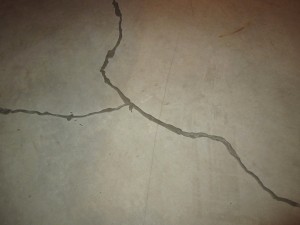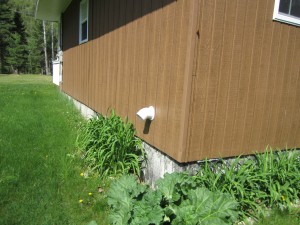First Nation Communities Facing an Invisible but Deadly Enemy
 It’s a colourless, odourless and tasteless gas that can be deadly. Now imagine your children playing in it, or community Elders sitting and visiting in it.
It’s a colourless, odourless and tasteless gas that can be deadly. Now imagine your children playing in it, or community Elders sitting and visiting in it.
That gas is radon, and, unbeknownst to the residents of the Tobique First Nation, a Maliseet community located in northwestern New Brunswick, some of them had been exposed to it.
Of Tobique’s approximately 2,000 members, close to 1,500 live on-reserve. As part of Health Canada’s National Radon Program testing, six public buildings on the First Nation community were tested for indoor radon gas a year ago. Five of them – including the community’s daycare, healing lodge and wellness centre – showed elevated levels of radon.
Health Canada and Aboriginal Affairs and Northern Development Canada worked with the community to address the high radon exposure in the buildings. Given the anxiety residents felt over Health Canada’s test results, a survey of homes was also initiated (home testing is not part of the National Strategy). According to the Tobique First Nation Residential Radon Report (posted below), many homes had high radon levels.
[documentcloud url=https://www.documentcloud.org/documents/420892-residential-radon-measurement-report-tobique.html format=normal sidebar=false ]
Debra Bear-Brideau’s home had Tobique’s highest level of indoor radon gas. Although her home got the work needed to fix the radon levels, she continues to worry about her family’s safety.
“We live in such an area with so much radon, that there’s always the possibility of it building back up again during winter,” says Bear-Brideau. “It’s kinda scary this invisible gas can come in your house and hurt your kids and family.”
Radon is formed by the breakdown of uranium in rocks and soil. “Within the province, areas that have certain types of rock (shale and granite) and soil can have higher levels of uranium in the ground, leading to more radon,” says Dr. Mariane Paquet, medical officer of health for northern New Brunswick.
Radon gas is measured in becquerels per cubic metre (Bq/m3). Higher numbers of becquerels mean higher levels of radon gas in the air.
“Since it is a gas, it can move freely through the soil enabling it to escape into the atmosphere or seep into buildings,” says Dr. Paquet.
Health Canada says remedial measures should be taken in a home or building when the radon concentration exceeds 200 Bq/m3.
Bear-Brideau’s home – like so many others in New Brunswick – had among the highest indoor radon concentrations in the country.
A cross-Canada project by the National Radon Program surveyed 14,000 homes over a two-year period (2009-2011). Among those New Brunswick homes tested, 18.7 per cent had between 200-600 Bq/m3 of radon, 6.1 per cent had levels above 600 Bq/m3.
Nova Scotia had the second highest percentages of indoor radon, followed by Newfoundland and Labrador and PEI.
When broken down by health region, Tobique First Nation — which is located within the Fredericton area (Health Region 3) — had a whopping 16.5 per cent of houses with radon levels above 600Bq/m3.
Despite work being done to raise awareness about radon and radon testing, it seems there still a long way to go. “I don’t think a lot of First Nations communities do radon testing,” says Sterling Perley, executive director of programs for the Tobique First Nation.
Simon Osmond, senior policy analyst with the Atlantic Policy Congress of First Nation Chiefs agrees. “I know Health Canada and CMHC at different times have provided some information,” says Osmond. “The thing is, information can only go so far, especially for cash stricken communities already trying to address other issues.”
Through an environmental survey, Statistics Canada asked Canadians how aware they were of radon and radon testing. In New Brunswick, most knew radon was a health hazard and could describe the radioactive gas, but ninety-five per cent had not tested for radon.
Bear-Brideau says she knew what radon was, but never knew it was in her house.

“My mother Pauline Bear asked a specialist about radon in the early 1980′s, but was told there wasn’t any radon around this area,” she says. “When I was in university I also inquired about radon in this area and was told the same thing. I had an inkling there was more to my fatigue and feeling unwell.”
Bear-Brideau explains that she often has sinus problems while her daughter has had pneumonia several times – leaving her to now wonder if it is related to the radon.
She is curious about another potential radon link. Recently, Health Canada reported that more than 3000 lung cancer deaths may be linked to indoor radon exposure. That doesn’t sit well with Bear-Brideau, whose family lost their ferret to lung cancer.
“It hit her really quick,” says Bear-Brideau. “All of a sudden she was coughing funny. I took her to the vet and the vet said she died of lung cancer. I’m concerned eventually I’ll go to the hospital one of these days and they’ll say ‘You have lung cancer.’”
To reduce radon gas in Bear-Brideau’s home, a radon mitigation system was installed. A vent pipe system and fan were placed within her home to pull the radon out of her house, and all cracks and other openings were properly sealed.
Kelley Bush, head of radon education and awareness for Health Canada, says the federal government is doing everything it can to raise awareness about radon and radon testing. “In the Atlantic region, we’re have partners with the Lung Association. They sell test kits for thirty-five dollars that includes the analysis too,” says Bush.

Roshini Kassie, manager at the New Brunswick Lung Association, has even gone as far as mailing test kits across the country. “It doesn’t prevent someone calling from PEI to call the New Brunswick Association to order a test kit,” says Kassie. “Or they can go on our Facebook page and order them.”
Although close to 200 radon tests are waiting to be collected for analysis at the Tobique First Nation, the community is taking the lead on raising awareness about radon and radon testing.
Health Canada is currently testing federal workplaces until the end of March 2013. A report is expected to be released at this time.
But in the meantime, Bear-Brideau says she will continue to leave her windows open as a precaution – even in winter.


I’m glad to see attention being raised to dangerous radon levels in FN communities, since it is a very important public health topic, but I think this article needs to be edited to clarify the relationship between radon and lung cancer earlier in the piece.
Radon causes lung cancer, definitively. It is the second-leading cause of lung cancer after smoking and causes an estimated 16% of all lung cancer cases in Canada. Referring to it as a dangerous, mysterious gas without clearly explaining what the danger is (lung cancer, due to breathing in radioactive gas; not sinus infections or pneumonia or anything else) will just contribute to needless concern and confusion.
The article presents the result of a Cross Canada radon survey. New Brunswick represents only 6% of the 14 000 measurements, but a third (1/3) – and not the anticipated 6% – of all Canadian measurements above 947 Bq/m3m. In a few communities initiatives such as radon measurement campaigns took place that could result in lower cost, but most often, it is the owner’s or the parents’ responsibility to take the initiative to order their own radon test from a reliable source such as the NB Lung association or C-NRPP radon professionals and to follow up when the report comes back over 200 Bq/m3.
Several local aboriginal communities show pragmatism and leadership while addressing radon issue. Radon in high concentration in homes can remain unnoticed and kills much more than other societal issues that are chronically developed in public media: e.g. more than texting and driving and drinking while driving combined. Victims slowly fade out in the quietness of an hospital rather than in the instant of a spectacular crash in a street or a highway. We are over 25 certified professionals whose expertise consists of mitigation of radon where it is too dangerous. One can easily contact us through C-NRPP.ca or Enviroporta.com phone 506 850 5510. Just like a roofer will stop a rain water leak, a radon professional will limit radon entry in your home in a secure way.
Since 2017, a new guideline for professional real estate agents will address radon issue with the support of a formal guide from the NBREA. In a nutshell, the seller becomes responsible for the radon mitigation of the home that they sell rather than selling to a buyer a possible radon trap.